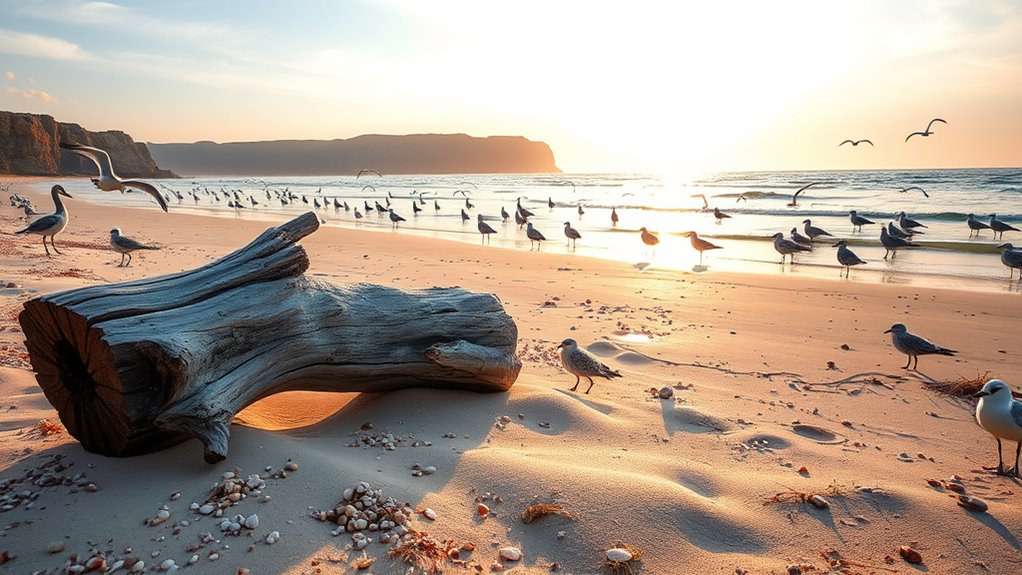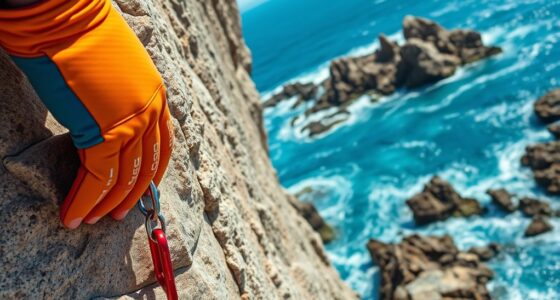To attract and spot coastal birds like herons, egrets, sandpipers, plovers, terns, pelicans, and cormorants, create a variety of shallow water zones, native vegetation, and quiet shoreline spots. Limit disturbances during nesting seasons and provide perch sites, reefs, or roosting areas. Recognize behaviors such as diving, probing, and flying patterns to identify species. Keep exploring further tips to make your shoreline more inviting for these fascinating visitors.
Key Takeaways
- Provide diverse shoreline habitats like mudflats, shallow pools, and native vegetation to attract species such as herons, egrets, and sandpipers.
- Maintain calm, undisturbed areas near nesting sites and roosts to encourage visiting migratory and breeding birds.
- Incorporate features like driftwood, rocks, and low perches to support resting and foraging behaviors of terns, pelicans, and cormorants.
- Ensure clean, shallow waters close to shore with abundant small fish and invertebrates to draw diving and probing species.
- Limit human disturbance during migration and breeding seasons, creating protected zones for key coastal bird species.
Common Herons and Egrets
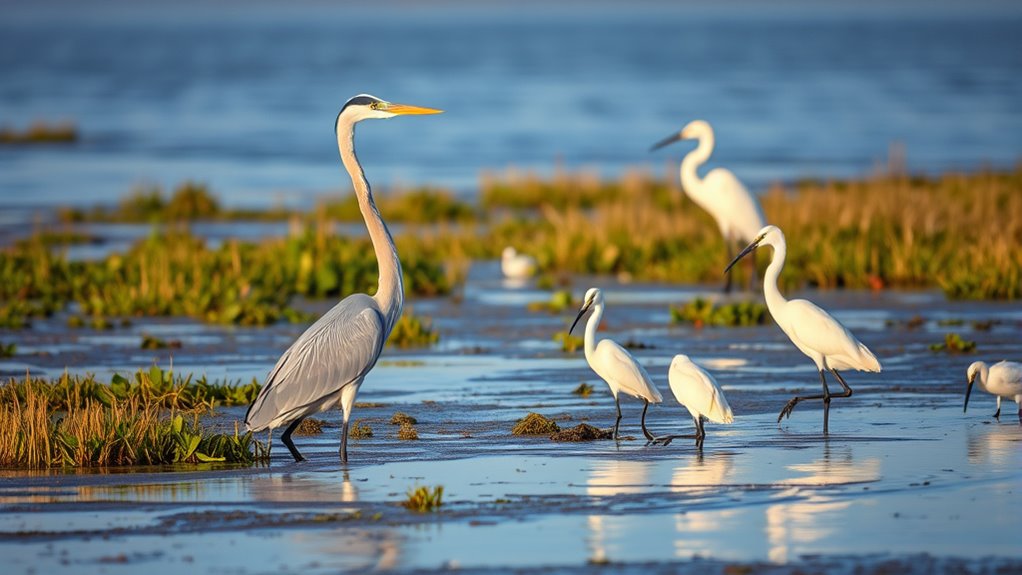
If you look along coastlines and wetlands, you’ll often spot common herons and egrets gracefully wading through shallow waters. These tall, slender birds stand still, patiently hunting for fish, frogs, and small invertebrates. Their long legs and sharp beaks make them efficient hunters, striking quickly to catch their prey. Herons typically have blue-gray feathers, while egrets often feature striking white plumage. They prefer quiet, undisturbed areas where they can forage without disturbance. You might notice them standing motionless for minutes, blending into their surroundings. To attract these birds, provide shallow water areas or plant native vegetation nearby. Maintaining calm, undisturbed environments encourages herons and egrets to settle and hunt comfortably, making your coastlines lively with their elegant presence. Additionally, wetland ecosystems play a crucial role in supporting the habitats that attract these species and help sustain their populations. Creating suitable habitats with native plantings can further enhance their presence and support their natural behaviors. Ensuring healthy aquatic habitats promotes abundant food sources, drawing more herons and egrets to your area. Promoting coastal conservation efforts can also help protect and preserve these important habitats for future generations.
Wading Birds: Sandpipers and Plovers
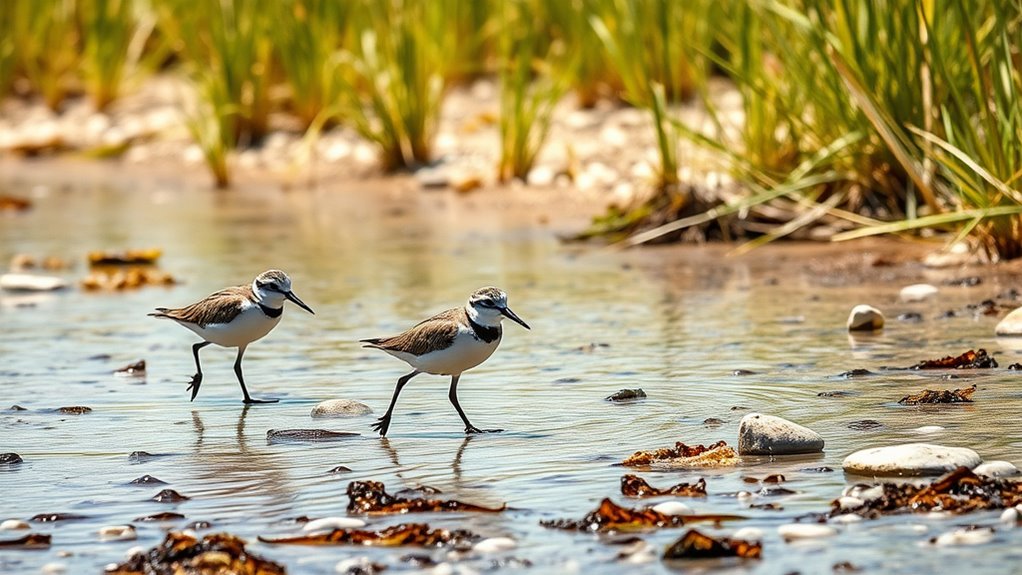
Wading birds like sandpipers and plovers thrive in mudflats and shoreline sands, where they search for small invertebrates. To catch them at their busiest, visit during high tide or early morning when they’re most active. Keep your eyes peeled for their quick movements along the water’s edge. Incorporating appropriate habitat considerations can enhance your chances of observing these species in their natural environment. Additionally, understanding wildlife behavior patterns can help you anticipate their movements and improve your bird-watching experience. Recognizing bird identification features is also crucial for accurately spotting and differentiating among species during your visit. Being familiar with tuning modifications can further enrich your understanding of diverse environments, much like tuning a vehicle to perform better in specific conditions.
Habitat and Feeding Habits
Sandpipers and plovers thrive along coastlines where they find shallow waters and sandy or muddy shores, providing ideal habitats for feeding. These birds rely on their environment for sustenance and have specific feeding habits.
- They probe the sand or mud with their beaks to find invertebrates like worms, crustaceans, and small mollusks.
- Their foraging occurs mostly during low tide, exposing rich feeding grounds.
- They often walk slowly along the shoreline, searching meticulously for food.
- Some species adapt to disturbed areas, including human-made mudflats, where they continue foraging efficiently.
Best Viewing Times
The best times to observe sandpipers and plovers are during low tide when their feeding grounds are most exposed. At this time, you’ll see them actively foraging along the shoreline, darting quickly to catch small invertebrates. Early mornings and late afternoons often provide the best lighting and calmer conditions, making spotting easier. During these periods, the birds tend to be more visible and less disturbed by human activity. Keep an eye on mudflats, sandbars, and tidal pools, where they gather in groups. Moving slowly and quietly increases your chances of a close sighting. Remember, tidal schedules vary by location, so check local tide charts before heading out. Timing your visit with low tide maximizes your opportunity to observe these fascinating wading birds at their most active.
Coastal Seagulls and Larids
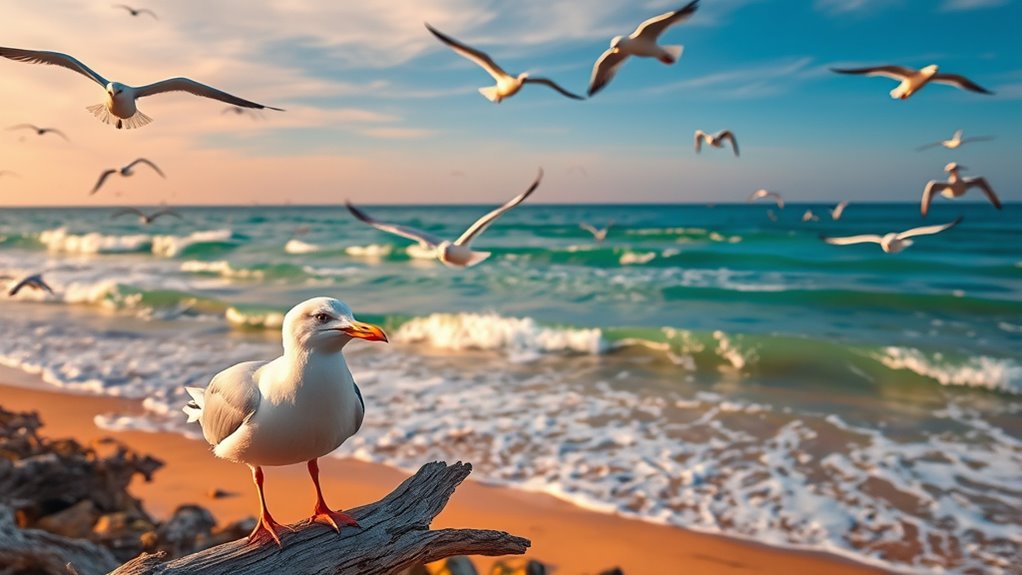
Coastal seagulls and larids are among the most familiar and widespread bird species you’ll encounter along shoreline habitats. They’re easily recognizable and often seen soaring or resting along beaches and piers. To identify and attract them, consider these tips:
Coastal gulls and larids are common, easily recognizable shoreline birds to observe and attract.
- Observe their behaviors—notice how they scavenge, dip for fish, or perch on rocks.
- Learn their calls—distinct sounds can help you locate active groups.
- Bring food scraps—offer bread or fish to attract them closer, but do so responsibly.
- Choose high vantage points—look for them soaring or gliding against the sky.
- Understand their feeding habits—knowing how they hunt and scavenge can improve your bird-watching experience, especially since feeding techniques play a significant role in attracting these species. Additionally, paying attention to their preferred habitats can greatly enhance your chances of seeing them up close. Recognizing their flight patterns can also help you anticipate their movements and locate them more easily.
Colorful Shorebirds: Turnstones and Red Knots
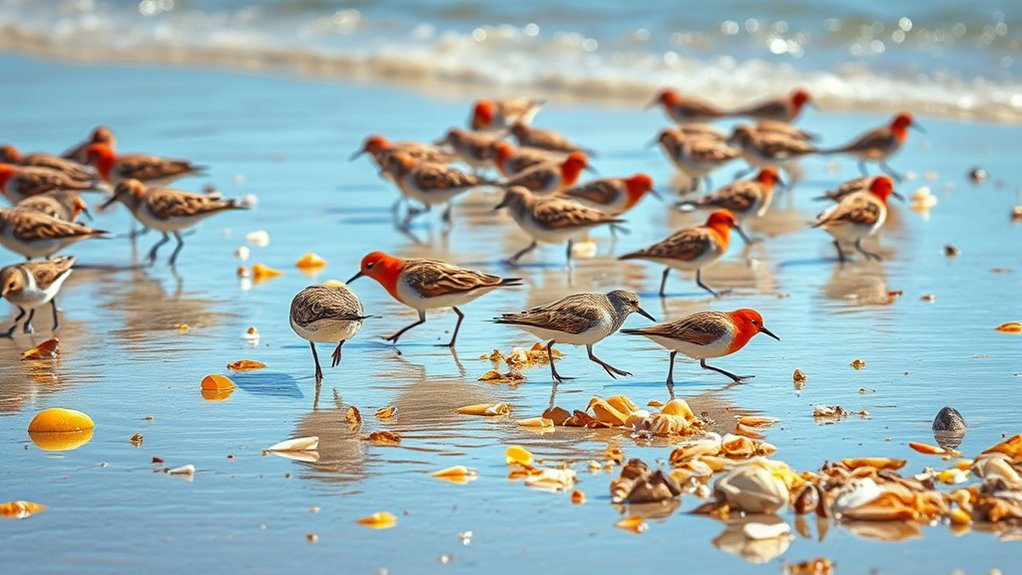
While exploring shoreline habitats, you’ll notice the vibrant plumage of turnstones and red knots, two colorful shorebird species that stand out against the sandy and rocky backdrop. Turnstones get their name from their habit of flipping over stones and debris to find food. They have striking black and white plumage with bright orange legs, making them easy to identify. Red knots, on the other hand, are known for their vivid red bills and legs during migration, along with mottled gray and brown bodies that blend into the shoreline. Both species are highly active, constantly probing the sand and rocks for invertebrates. To attract them, keep your distance and avoid disturbing their feeding grounds. Providing a diverse shoreline with tidal flats and mudflats encourages these energetic birds to visit and stay longer.
Surf and Tern Species
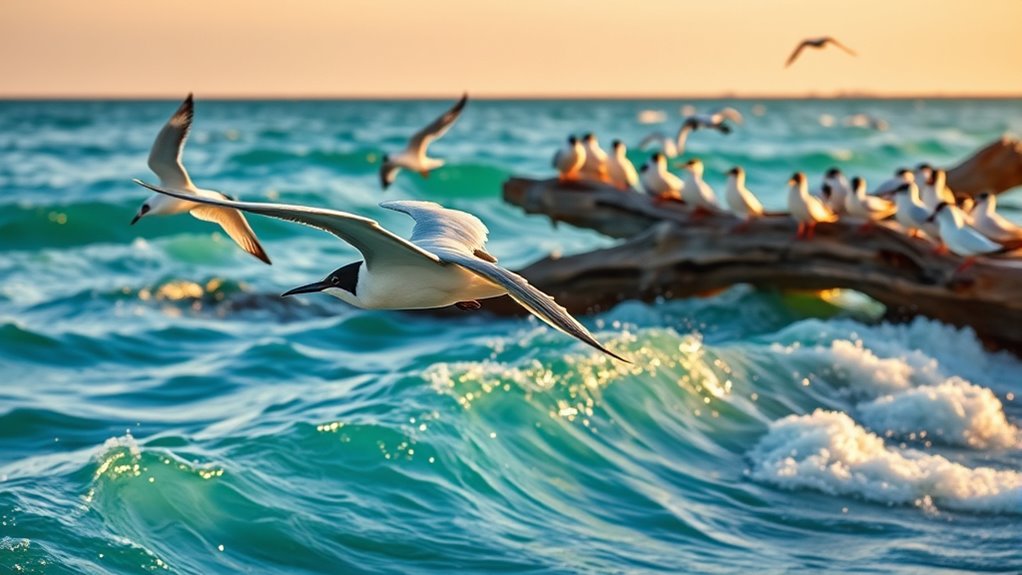
When observing surf and tern species, you’ll learn to identify their distinctive shapes and flight patterns. Their preferred habitats include beaches, rocky shores, and open waters, where they display unique behaviors like foraging and courtship. To attract terns, try setting out fish or creating quiet, undisturbed spots along the shoreline. Understanding vibe coding techniques can help you customize bird-friendly environments more effectively. Additionally, incorporating performance upgrades such as quiet nesting areas can encourage more terns to settle and breed in your area. Recognizing the importance of coastal zones and their natural features can further enhance your bird-watching experience and support conservation efforts. Applying contrast ratio considerations can improve your ability to spot these species against the natural background. Moreover, employing leadership skills such as patience and observation can greatly increase your success in bird-watching activities.
Recognizing Surf and Tern Birds
Surf and tern birds are among the most recognizable species you’ll encounter along the shoreline, thanks to their distinctive shapes, behaviors, and plumage. To identify them, focus on these key features:
- Shape and Size: Terns are sleek with slender bodies, pointed wings, and sharp bills, while surf birds like sandpipers have rounded bodies and short legs.
- Plumage: Terns often have white bodies with black caps or markings, whereas surf birds display mottled browns, grays, or whites.
- Flight Pattern: Terns glide gracefully and hover briefly, while surf birds often run along the water’s edge or probe mudflats.
- Behavior: Terns dive for fish, showing quick, darting movements, whereas surf birds forage by pecking or probing the sand.
Habitats and Behavior Traits
Surf and tern birds occupy distinct habitats that influence their behavior and feeding strategies. Surfbirds prefer rocky shores and tidal flats, where they forage by probing the mud for invertebrates. Terns, on the other hand, thrive along sandy beaches and open waters, diving to catch fish. Their different environments shape their actions and feeding methods.
Additionally, feeding strategies vary significantly between these species, reflecting their adaptations to their specific habitats.
Tips to Attract Terns
To attract terns effectively, you should focus on creating a welcoming environment along sandy beaches and open waters where they thrive. Terns are drawn to areas with minimal disturbance and plenty of food sources. To enhance your chances, consider these tips:
- Provide shallow, sandy nesting sites free of debris and predators.
- Maintain clear, clean water close to shore to attract small fish and baitfish.
- Set up unobtrusive perches or low structures for resting and loafing.
- Limit human activity during breeding season to avoid disturbing their nesting colonies.
Pelicans and Cormorants
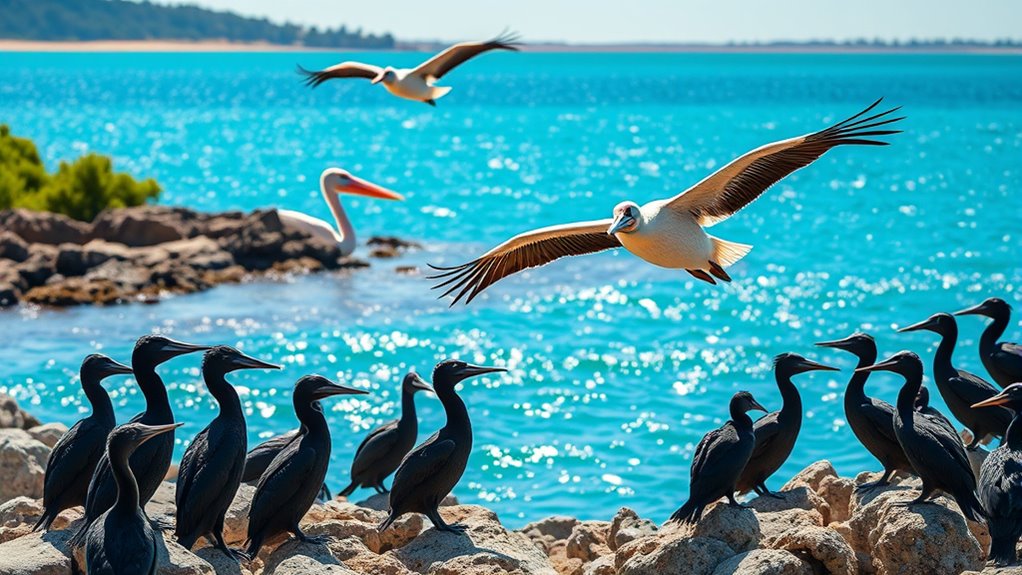
Have you ever watched a flock of pelicans or cormorants glide effortlessly over the water? These birds are striking and easy to spot along coastlines. Pelicans often form V-shaped formations, soaring high and then plunging to catch fish. Cormorants dive underwater, chasing prey with swift precision. To attract them, provide shallow waters and roosting trees nearby. Understanding their habitat needs helps you observe them closely. Here’s a quick guide:
| Bird Type | Typical Habitat | Feeding Behavior |
|---|---|---|
| Pelicans | Shallow coastal waters, beaches | Surface feeding, soaring |
| Cormorants | Rocky shores, piers | Diving underwater |
| Both | Open water, estuaries | Fish hunting, social roosts |
Spotting these birds enriches your coastal experience and deepens your connection with marine life. Recognizing their habitat needs can greatly enhance your bird-watching success.
Migratory Bird Visitors
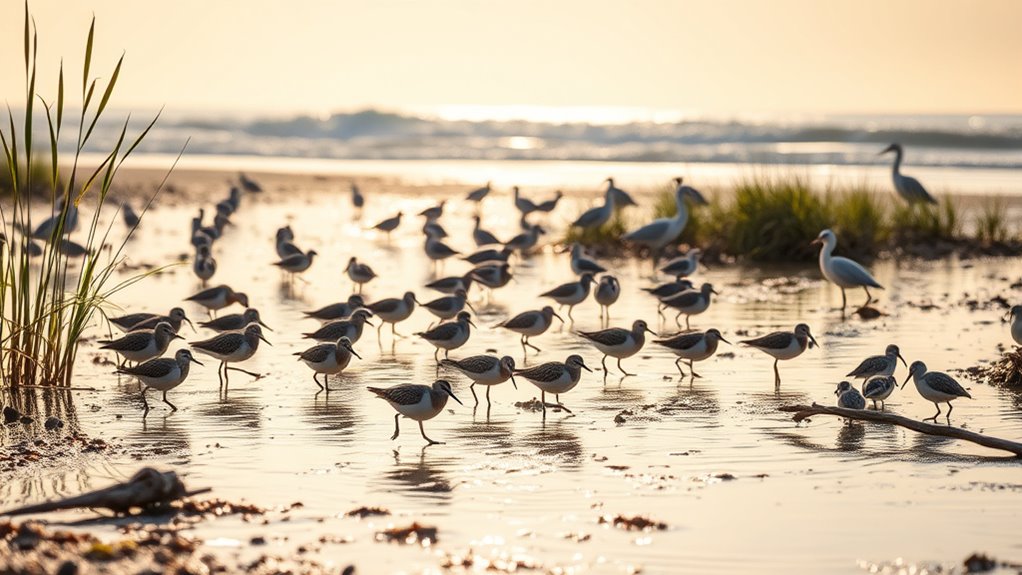
Ever wonder which birds travel great distances to visit coastal areas each year? Migratory birds add vibrancy to your shoreline, crossing continents to reach their breeding or wintering grounds. Here are four common visitors:
- Sandpipers – Swift and agile, they stop to forage along mudflats during migration.
- Brant Geese – These geese travel from northern Canada to winter along coastlines.
- Arctic Terns – Known for their incredible 25,000-mile journey between Arctic breeding sites and Antarctic wintering grounds.
- Plovers – Small yet resilient, they arrive in spring and depart in fall, often seen scurrying across sandy beaches. Their seasonal visits bring dynamic movement and lively activity, making coastal bird-watching a truly rewarding experience. Seasonal migration patterns influence the timing and number of these visitors, enriching the diversity of coastal ecosystems. Additionally, understanding regional bird populations can help enthusiasts better anticipate migration peaks and enhance their bird-watching experiences. Recognizing how migratory behaviors are affected by climate change can also provide deeper insights into shifts in bird distribution and timing, highlighting the importance of conserving migration corridors for future generations. Studying climate change impacts on migratory patterns is essential for developing effective conservation strategies.
Creating a Bird-Friendly Shoreline Environment
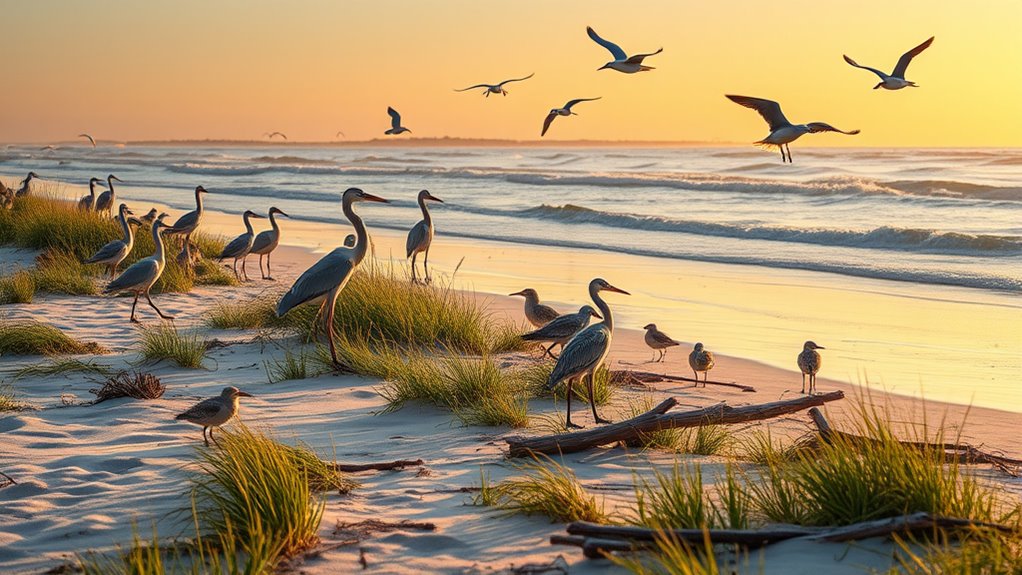
Migratory birds bring lively energy to coastal areas, but creating a bird-friendly shoreline can help guarantee they continue to visit and thrive. Start by leaving some natural debris, like driftwood and rocks, to provide cover and foraging spots. Plant native dune grasses and shrubs to stabilize the shoreline and offer shelter. Avoid aggressive landscaping or invasive plants that can disrupt native habitats. Limit human activity near nesting sites, especially during breeding season, to prevent disturbances. Incorporate shallow pools or tide pools that attract shorebirds searching for food. Installing minimal, bird-safe fencing prevents predators and keeps birds safe. By maintaining a natural, undisturbed environment, you create an inviting space that supports the diverse needs of coastal birds year-round. Incorporating low-carb landscaping techniques can also reduce habitat disturbance and promote native plant growth, benefiting the local bird populations. Additionally, choosing native plants over invasive species further enhances habitat stability and encourages a healthy ecosystem.
Essential Tips for Bird Watching Success
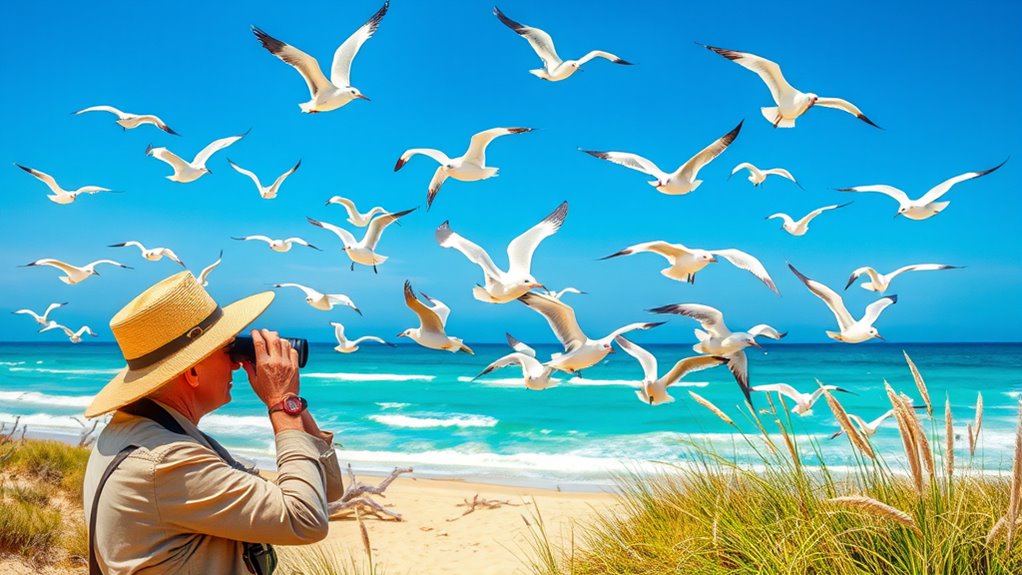
To succeed in bird watching, you need to be prepared and attentive. First, arrive early when birds are most active and sightings are plentiful. Second, bring binoculars with good magnification to see details clearly. Third, keep your movements slow and quiet to avoid scaring birds away. Fourth, learn to identify bird calls and songs; these clues often reveal hidden species. Additionally, wear neutral clothing to blend into the environment and carry a field guide or bird app for quick reference. Stay patient, as birds may take time to appear, and avoid sudden movements. By following these tips, you’ll increase your chances of spotting diverse coastal species and enjoying a rewarding bird-watching experience.
Frequently Asked Questions
Which Coastal Bird Species Are Most Endangered?
You’re wondering which coastal bird species are most endangered. Many, like the piping plover and red knot, face threats from habitat loss, pollution, and climate change. By supporting conservation efforts and avoiding disturbance during breeding seasons, you can help protect these vulnerable birds. Your actions, such as respecting nesting sites and reducing pollution, directly contribute to their survival. Every effort counts in preserving these incredible coastal species for future generations.
How Can I Identify Different Bird Calls Accurately?
You can identify different bird calls accurately by paying close attention to pitch, rhythm, and tone. Use a good field guide or bird call app to compare sounds, and listen carefully in various conditions to recognize patterns. Practice regularly by recording calls and reviewing them later. Over time, you’ll become more confident distinguishing species, making your bird-watching experience more enjoyable and insightful.
What Are the Best Times of Year for Migratory Birds?
You should focus on the best times of year for migratory birds to maximize your bird-watching success. Typically, spring and fall are prime seasons, as birds migrate to and from breeding grounds. During these periods, you’ll see a surge of species passing through coastal areas. Keep an eye on local birding reports and seasonal charts to plan your visits, ensuring you catch the most vibrant and diverse migrations.
Are There Specific Spots Best for Beginner Bird Watchers?
Think of bird-watching as opening a treasure chest—you don’t need to go far to find gems. For beginners, simple spots like local parks, nature reserves, or lakes are your starting keys. These areas act as welcoming gateways, offering easy sightings and a gentle introduction to birding. With patience and curiosity, you’ll soon discover the symphony of sights and sounds that make each spot a rewarding adventure.
How Do Weather Conditions Affect Bird Activity Along the Coast?
Weather conditions greatly influence bird activity along the coast. When it’s sunny and calm, birds tend to be more active, feeding and flying freely. On windy or stormy days, they often stay hidden or seek shelter, making spotting harder. Cooler temperatures can also slow down their movements, while warm, clear days encourage more movement and singing. To maximize your sightings, plan your bird-watching trips during mild weather when activity peaks.
Conclusion
By embracing the beauty and bustle of coastal birdwatching, you’ll foster fascination and fulfillment. With patience, passion, and a little preparation, you’ll witness wondrous winged wonders and deepen your connection to nature’s coastal canvas. So, seize the serenity, savor the spectacle, and let your love for lively, lovely birds lead you to unforgettable adventures. Immerse yourself, discover, and delight in the dazzling diversity of coastal birds awaiting your attentive eye.

